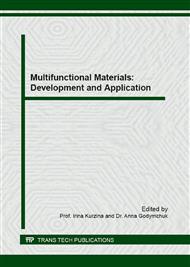[1]
J. Zhang, C.Q. Lan, Nickel and cobalt nanoparticles produced by laser ablation of solids in organic solution, Mat. Let. 62, 10-11 (2008) 1521-1524.
DOI: 10.1016/j.matlet.2007.09.038
Google Scholar
[2]
A.S. Kurlov, A.A. Rempel, V.I. Matrenin, A.S. Stikhin, Morphology and crystal-chemical characteristics of cobalt and nickel nanopowders prepared by thermochemical and electrolytic methods, J. Inorg. Mat. 49, 2 (2013) 153-158.
DOI: 10.1134/s0020168513020118
Google Scholar
[3]
Z. Zhang, X. Chen, X. Zhang, C. Shi, Synthesis and magnetic properties of nickel and cobalt nanoparticles obtained in DMF solution, Solid State Commun. 139, 8 (2006) 403-405.
DOI: 10.1016/j.ssc.2006.06.040
Google Scholar
[4]
H. Shao, Y. Huang, H. Lee, Y.J. Suh, C.O. Kim, Cobalt nanoparticles synthesis from Co(CH3COO)2 by thermal decomposition, J. Magn. Magn. Mater. 304, 1 (2006) 28-30.
DOI: 10.1016/j.jmmm.2006.02.032
Google Scholar
[5]
S. Chandra, A. Kumar, P.K. Tomar, Synthesis of Ni nanoparticles and their characterizations, J. Saudi Chem. Soc. 18, 5 (2014) 437-442.
DOI: 10.1016/j.jscs.2011.09.008
Google Scholar
[6]
V.M. Rao, C.H. Castano, J. Rojas, A.J. Abdulghani, Synthesis of nickel nanoparticles on multi-walled carbon nanotubes by gamma irradiation, Radiat. Phys. Chem. 89 (2013) 51-56.
DOI: 10.1016/j.radphyschem.2013.04.006
Google Scholar
[7]
N.R.N. Roselina, A. Azizan, K.M. Hyie, A. Jumahat, M.A.A. Bakar, Effect of pH on Formation of Nickel Nanostructures through Chemical Reduction Method, Procedia Eng. 68 (2013) 43-48.
DOI: 10.1016/j.proeng.2013.12.145
Google Scholar
[8]
A.N. Popova, Y.A. Zaharov, V.M. Pugachev, Chemical synthesis, structure and magnetic properties of nanocrystalline Fe–Co alloys, Mat. Let. 74 (2012) 173-175.
DOI: 10.1016/j.matlet.2012.01.090
Google Scholar
[9]
Y.A. Zakharov, V.M. Pugachev, V.V. Kriventsov, A.N. Popova, Structure of nanosize bimetals Fe-Co and Fe-Ni, Bull. Russ. Acad. Sci. Phys. 77, 2 (2013) 142.
DOI: 10.3103/s106287381302041x
Google Scholar
[10]
Y.A. Zaharov, V.M. Pugachev, V.G. Dodonov, A.N. Popova, Nanosize powders of transition metals binary systems, J. Phys. Conf. Ser. 345, 1 (2012) 012024.
DOI: 10.1088/1742-6596/345/1/012024
Google Scholar
[11]
A.N. Popova, Synthesis and characterization of iron-cobalt nanoparticles, J. Phys. Conf. Ser. 345, 1 (2012) 012030.
DOI: 10.1088/1742-6596/345/1/012030
Google Scholar


